Highway Planning Trends: A Bibliometric Analysis
Abstract
:1. Introduction
2. Background
2.1. Causes of Shortcomings in Highway Planning
2.2. Effects of Shortcomings in Highway Planning
2.3. Bibliometric Studies in the Highway Field
3. Research Method
3.1. Scope Definition
- Research Objective 1: Synthesize the development metrics of the highway project planning topic.
- Research Objective 2: Characterize the knowledge structure and trends of the highway planning topic.
3.2. Selection of Bibliometric Analysis Techniques
3.3. Data Collection
3.4. Bibliometric Analysis Execution
3.5. Evidence Analysis and Synthesis
4. Results
4.1. Performance Analysis
4.1.1. Scientific Production
4.1.2. Affiliations and Country Scientific Production
4.1.3. Sources
4.2. Science Mapping
4.2.1. General Map
4.2.2. Thematic Map
4.2.3. Cluster Analysis
Niche Themes
Motor Themes
Emerging or Declining Themes
Basic and Transversal Themes
4.3. Trend Analysis
4.3.1. The Trend of the Most Relevant Words
4.3.2. Methodological and Technological Trends
5. Conclusions
Author Contributions
Funding
Institutional Review Board Statement
Informed Consent Statement
Data Availability Statement
Acknowledgments
Conflicts of Interest
References
- Mohammadi, A.; Igwe, C.; Amador, L.; Nasiri, F. Applying lean construction principles in road maintenance planning and scheduling. Int. J. Constr. Manag. 2020, 1–11. [Google Scholar] [CrossRef]
- Lee, J.; Yoon, Y. Indicators development to support intelligent road infrastructure in urban cities. Transp. Policy 2021, 114, 252–265. [Google Scholar] [CrossRef]
- Lu, X.; Jones, S.; Li, L.; Han, X. Balancing road infrastructure and socioeconomic development in China—Proposed application of the coupling coordinated degree. Res. Transp. Bus. Manag. 2020, 37, 100480. [Google Scholar] [CrossRef]
- Amare, Y.; Quezon, E.T.; Busier, M. Causes of delays during construction phase of road projects due to the failures of contractor, consultant, and employer in Addis Ababa City Road Authority. Int. J. Sci. Eng. Res. 2017, 8, 15–25. [Google Scholar]
- Herrera, R.F.; Sánchez, O.; Castañeda, K.; Porras, H. Cost overrun causative factors in road infrastructure projects: A frequency and importance analysis. Appl. Sci. 2020, 10, 5506. [Google Scholar] [CrossRef]
- Issa, A.; Bdair, R.; Abu-Eisheh, S. Assessment of compliance to planned cost and time for implemented municipal roads projects in Palestine. Ain Shams Eng. J. 2021, 13, 101578. [Google Scholar] [CrossRef]
- Zhao, Y.; Li, Z.; Gao, L.; Xiong, J. Road-feature-based multiparameter road complexity calculation model of off-road environment. Math. Probl. Eng. 2018, 2018, 1–12. [Google Scholar] [CrossRef] [Green Version]
- Moreno, A.; Alem, D.; Gendreau, M.; Munari, P. The heterogeneous multicrew scheduling and routing problem in road restoration. Transp. Res. Part B Methodol. 2020, 141, 24–58. [Google Scholar] [CrossRef]
- Yogesh, G.; Hanumanth Rao, C. A study on linear scheduling methods in road construction projects. Mater. Today Proc. 2021, 47, 5475–5478. [Google Scholar] [CrossRef]
- Santos, J.; Flintsch, G.; Ferreira, A. Environmental and economic assessment of pavement construction and management practices for enhancing pavement sustainability. Resour. Conserv. Recycl. 2017, 116, 15–31. [Google Scholar] [CrossRef] [Green Version]
- Ikechukwua, U.; Davida, M.; Naeimeha, J.; Temitopeb, O. Sustainability rating system for highway design—A key focus for developing sustainable cities and societies in Nigeria. Sustain. Cities Soc. 2022, 78, 103620. [Google Scholar] [CrossRef]
- Mukhuty, S.; Upadhyay, A.; Rothwell, H. Strategic sustainable development of Industry 4.0 through the lens of social responsibility: The role of human resource practices. Bus. Strateg. Environ. 2022, 1–14. [Google Scholar] [CrossRef]
- Sharma, M.; Kumar, A.; Luthra, S.; Joshi, S.; Upadhyay, A. The impact of environmental dynamism on low-carbon practices and digital supply chain networks to enhance sustainable performance: An empirical analysis. Bus. Strateg. Environ. 2022. [Google Scholar] [CrossRef]
- Jiang, R.; Wu, C.; Song, Y.; Wu, P. Estimating carbon emissions from road use, maintenance and rehabilitation through a hybrid life cycle assessment approach—A case study. J. Clean. Prod. 2020, 277, 123276. [Google Scholar] [CrossRef]
- Hoxha, E.; Vignisdottir, H.R.; Barbieri, D.M.; Wang, F.; Bohne, R.A.; Kristensen, T.; Passer, A. Life cycle assessment of roads: Exploring research trends and harmonization challenges. Sci. Total Environ. 2021, 759, 143506. [Google Scholar] [CrossRef]
- Cristiano, S. The “price” of saved time, the illusion of saved fuel: Life-Cycle Assessment of a major highway expansion. J. Clean. Prod. 2022, 344, 131087. [Google Scholar] [CrossRef]
- Kothari, C.; France-Mensah, J.; O’Brien, W. Developing a Sustainable Pavement Management Plan: Economics, Environment, and Social Equity. J. Infrastruct. Syst. 2022, 28, 04022009. [Google Scholar] [CrossRef]
- Xu, J.; Zhang, Z.; Rong, J. The campus road planning and design research. Procedia-Soc. Behav. Sci. 2012, 43, 579–586. [Google Scholar] [CrossRef] [Green Version]
- Lee, E.; Chakraborty, D.; McDonald, M. Predicting oil production sites for planning road infrastructure: Trip generation using sir epidemic model. Infrastructures 2021, 6, 15. [Google Scholar] [CrossRef]
- Castañeda, K.; Sánchez, O.; Herrera, R.F.; Pellicer, E.; Porras, H. BIM-based traffic analysis and simulation at road intersection design. Autom. Constr. 2021, 131, 10391. [Google Scholar] [CrossRef]
- Ershova, S.; Smirnov, E. Conceptual justification of town-planning design standards for streets and roads in large cities for ensuring traffic safety. Transp. Res. Procedia 2017, 20, 180–184. [Google Scholar] [CrossRef]
- Aguiar, M.O.; Fernandes da Silva, G.; Mauri, G.R.; Ribeiro de Mendonça, A.; Junio de Oliveira Santana, C.; Marcatti, G.E.; Marques da Silva, M.L.; Ferreira da Silva, E.; Figueiredo, E.O.; Martins Silva, J.P.; et al. Optimizing forest road planning in a sustainable forest management area in the Brazilian Amazon. J. Environ. Manag. 2021, 288, 112332. [Google Scholar] [CrossRef] [PubMed]
- Xu, H.; Zhao, G.; Fagerholm, N.; Primdahl, J.; Plieninger, T. Participatory mapping of cultural ecosystem services for landscape corridor planning: A case study of the Silk Roads corridor in Zhangye, China. J. Environ. Manage. 2020, 264, 110458. [Google Scholar] [CrossRef] [PubMed]
- Suprayoga, G.B.; Witte, P.; Spit, T. Coping with strategic ambiguity in planning sustainable road development: Balancing economic and environmental interests in two highway projects in Indonesia. Impact Assess. Proj. Apprais. 2020, 38, 233–244. [Google Scholar] [CrossRef] [Green Version]
- Rey, D.; Bar-Gera, H. Long-term scheduling for road network disaster recovery. Int. J. Disaster Risk Reduct. 2020, 42, 101353. [Google Scholar] [CrossRef]
- Instituto Nacional de Invias. Manual del Diseño Geométrico de Carreteras; Instituto Nacional de Invias: Bogotá, Colombia, 2008. [Google Scholar]
- Żabick, P.; Gardziejczyk, W. Multicriteria analysis in planning roads—Part 1. Criteria in determining the alignment of regional roads. Bull. Polish Acad. Sci. 2020, 68, 345–350. [Google Scholar] [CrossRef]
- Lee, H.Y. Optimizing schedule for improving the traffic impact of work zone on roads. Autom. Constr. 2009, 18, 1034–1044. [Google Scholar] [CrossRef]
- Li, S.; Ma, Z.; Teo, K.L. A new model for road network repair after natural disasters: Integrating logistics support scheduling with repair crew scheduling and routing activities. Comput. Ind. Eng. 2020, 145, 106506. [Google Scholar] [CrossRef]
- García-Alviz, J.; Galindo, G.; Arellana, J.; Yie-Pinedo, R. Planning Road Network Restoration and Relief Distribution under Heterogeneous Road Disruptions; Springer: Berlin/Heidelberg, Germany, 2021; Volume 43, ISBN 0123456789. [Google Scholar]
- Shah, R.K. A new approach for automation of location-based earthwork scheduling in road construction projects. Autom. Constr. 2014, 43, 156–169. [Google Scholar] [CrossRef]
- Liao, S.M.; Cheng, C.H.; Chen, L.S. The planning and construction of a large underpass crossing urban expressway in Shanghai: An exemplary solution to the traffic congestions at dead end roads. Tunn. Undergr. Sp. Technol. 2018, 81, 367–381. [Google Scholar] [CrossRef]
- Amândio, A.M.; Coelho das Neves, J.M.; Parente, M. Intelligent planning of road pavement rehabilitation processes through optimization systems. Transp. Eng. 2021, 5, 100081. [Google Scholar] [CrossRef]
- Donthu, N.; Kumar, S.; Mukherjee, D.; Pandey, N.; Lim, W.M. How to conduct a bibliometric analysis: An overview and guidelines. J. Bus. Res. 2021, 133, 285–296. [Google Scholar] [CrossRef]
- Gidado, K.I. Project complexity: The focal point of construction production planning. Constr. Manag. Econ. 1996, 14, 213–225. [Google Scholar] [CrossRef]
- Porras, H.; Sanchez, O.; Galvis, J. Metodología para la elaboración de modelos del proceso constructivo 5d con tecnologías “building information modeling”. Rev. Gti 2014, 14, 59–73. [Google Scholar]
- Hosseininasab, S.M.; Shetab-Boushehri, S.N.; Hejazi, S.R.; Karimi, H. A multi-objective integrated model for selecting, scheduling, and budgeting road construction projects. Eur. J. Oper. Res. 2018, 271, 262–277. [Google Scholar] [CrossRef]
- Krzemiński, M.; Wypysiak, A. Scheduling complete review application for road works. Procedia Eng. 2014, 91, 400–405. [Google Scholar] [CrossRef] [Green Version]
- Nusen, P.; Boonyung, W.; Nusen, S.; Panuwatwanich, K.; Champrasert, P.; Kaewmoracharoen, M. Construction planning and scheduling of a renovation project using bim-based multi-objective genetic algorithm. Appl. Sci. 2021, 11, 4716. [Google Scholar] [CrossRef]
- Castañeda, K.; Sánchez, O.; Porras, H. Planificación del flujo de caja de proyectos de construcción basada en BIM y dinámica de sistemas. Entramado 2021, 17, 272–288. [Google Scholar] [CrossRef]
- Mejía, G.; Sánchez, O.; Castañeda, K.; Pellicer, E. Delay causes in road infrastructure projects in developing countries. J. Constr. 2020, 10, 221–235. [Google Scholar] [CrossRef]
- Irfan, M.; Malik, M.S.A.; Kaka Khel, S.S.U.H. Effect of factors of organizational structure influencing nonphysical waste in road projects of developing countries. Eng. Constr. Archit. Manag. 2020, 27, 3135–3153. [Google Scholar] [CrossRef]
- Pritchard, M.S. Safety, security, and serviceability in road engineering. Accid. Anal. Prev. 2019, 127, 172–176. [Google Scholar] [CrossRef] [PubMed]
- Perera, B.A.K.S.; Ekanayake, B.J.; Jayalath, C.; Jayathilaka, G.R.H. A study on variation-specific disputes that arise in road projects in Sri Lanka: A qualitative approach. Int. J. Constr. Manag. 2021, 21, 571–581. [Google Scholar] [CrossRef]
- Mishmish, M.; El-Sayegh, S.M. Causes of claims in road construction projects in the UAE. Int. J. Constr. Manag. 2018, 18, 26–33. [Google Scholar] [CrossRef]
- Luangcharoenrat, C.; Intrachooto, S.; Peansupap, V.; Sutthinarakorn, W. Factors influencing construction waste generation in building construction: Thailand’s perspective. Sustainability 2019, 11, 3638. [Google Scholar] [CrossRef] [Green Version]
- Yap, J.B.H.; Goay, P.L.; Woon, Y.B.; Skitmore, M. Revisiting critical delay factors for construction: Analysing projects in Malaysia. Alexandria Eng. J. 2021, 60, 1717–1729. [Google Scholar] [CrossRef]
- Sánchez, O.; Castañeda, K.; Mejía, G.; Pellicer, E. Delay factors: A comparative analysis between road infrastructure and building projects. In Proceedings of the Construction Research Congress 2020, Tempe, Arizona, 8–10 March 2020; American Society of Civil Engineers: Tempe, Arizona, 2020; pp. 223–231. [Google Scholar]
- Angarita-Zapata, J.S.; Maestre-Gongora, G.; Calderín, J.F. A bibliometric analysis and benchmark of machine learning and automl in crash severity prediction: The case study of three colombian cities. Sensors 2021, 21, 8401. [Google Scholar] [CrossRef]
- Haghani, M.; Behnood, A.; Oviedo-Trespalacios, O.; Bliemer, M.C.J. Structural anatomy and temporal trends of road accident research: Full-scope analyses of the field. J. Safety Res. 2021, 79, 173–198. [Google Scholar] [CrossRef]
- Ospina-Mateus, H.; Quintana Jiménez, L.A.; Lopez-Valdes, F.J.; Salas-Navarro, K. Bibliometric analysis in motorcycle accident research: A global overview. Scientometrics 2019, 121, 793–815. [Google Scholar] [CrossRef]
- Zou, X.; Vu, H.L. Mapping the knowledge domain of road safety studies: A scientometric analysis. Accid. Anal. Prev. 2019, 132, 105243. [Google Scholar] [CrossRef]
- Siri, S.; Pasquale, C.; Sacone, S.; Ferrara, A. Freeway traffic control: A survey. Automatica 2021, 130, 109655. [Google Scholar] [CrossRef]
- Kaffash, S.; Nguyen, A.T.; Zhu, J. Big data algorithms and applications in intelligent transportation system: A review and bibliometric analysis. Int. J. Prod. Econ. 2021, 231, 107868. [Google Scholar] [CrossRef]
- Astarita, V.; Giofrè, V.P.; Mirabelli, G.; Solina, V. A Review of Blockchain-Based Systems in Transportation. Information 2020, 11, 21. [Google Scholar] [CrossRef] [Green Version]
- Zamani, M.; Yalcin, H.; Naeini, A.B.; Zeba, G.; Daim, T.U. Developing metrics for emerging technologies: Identification and assessment. Technol. Forecast. Soc. Chang. 2022, 176, 121456. [Google Scholar] [CrossRef]
- Wang, H.; Zhang, W.; Zhang, Y.; Xu, J. A bibliometric review on stability and reinforcement of special soil subgrade based on CiteSpace. J. Traffic Transp. Eng. 2022, 9, 223–243. [Google Scholar] [CrossRef]
- Sood, S.K.; Kumar, N.; Saini, M. Scientometric Analysis of Literature on Distributed Vehicular Networks: VOSViewer Visualization Techniques; Springer: Dordrecht, The Netherlands, 2021; Volume 54, ISBN 1046202109980. [Google Scholar]
- Rodríguez, M.V.; Melgar, S.G.; Cordero, A.S.; Márquez, J.M.A. A critical review of unmanned aerial vehicles (Uavs) use in architecture and urbanism: Scientometric and bibliometric analysis. Appl. Sci. 2021, 11, 9966. [Google Scholar] [CrossRef]
- Nalbandian, K.M.; Carpio, M.; González, Á. Analysis of the scientific evolution of self-healing asphalt pavements: Toward sustainable road materials. J. Clean. Prod. 2021, 293, 126107. [Google Scholar] [CrossRef]
- Abdelmageed, S.; Zayed, T. A study of literature in modular integrated construction—Critical review and future directions. J. Clean. Prod. 2020, 277, 124044. [Google Scholar] [CrossRef]
- Han, R.; Zhou, B.; Huang, Y.; Lu, X.; Li, S.; Li, N. Bibliometric overview of research trends on heavy metal health risks and impacts in 1989–2018. J. Clean. Prod. 2020, 276, 123249. [Google Scholar] [CrossRef]
- Meyer, T. Decarbonizing road freight transportation—A bibliometric and network analysis. Transp. Res. Part D Transp. Environ. 2020, 89, 102619. [Google Scholar] [CrossRef]
- Chang, X.; Zhang, R.; Xiao, Y.; Chen, X.; Zhang, X.; Liu, G. Mapping of publications on asphalt pavement and bitumen materials: A bibliometric review. Constr. Build. Mater. 2020, 234, 117370. [Google Scholar] [CrossRef]
- Domínguez, J.; Mateo, T. Review on V2X, I2X, and P2X communications and their applications: A comprehensive analysis over Time. Sensors 2019, 19, 2756. [Google Scholar] [CrossRef] [PubMed] [Green Version]
- Wolff, M.C.; Brito Lima, G.; Caldas, M.A.F. Análise das estratégias de mitigação das emissões de gases do efeito estufa no transporte rodoviário com apoio da revisão sistemática. Espacios 2017, 38, 20–33. [Google Scholar]
- Moral-Muñoz, J.A.; Cobo, M.J.; Chiclana, F.; Collop, A.; Herrera-Viedma, E. Analyzing Highly Cited Papers in Intelligent Transportation Systems. IEEE Trans. Intell. Transp. Syst. 2016, 17, 993–1001. [Google Scholar] [CrossRef] [Green Version]
- Radu, V.; Radu, F.; Tabirca, A.I.; Saplacan, S.I.; Lile, R. Bibliometric Analysis of Fuzzy Logic Research in International Scientific Databases. Int. J. Comput. Commun. Control 2021, 16, 1–20. [Google Scholar] [CrossRef]
- Snyder, H. Literature review as a research methodology: An overview and guidelines. J. Bus. Res. 2019, 104, 333–339. [Google Scholar] [CrossRef]
- Sun, C.; Hon, C.K.H.; Way, K.A.; Jimmieson, N.L.; Xia, B. The relationship between psychosocial hazards and mental health in the construction industry: A meta-analysis. Saf. Sci. 2022, 145, 105485. [Google Scholar] [CrossRef]
- Hussein, M.; Zayed, T. Critical factors for successful implementation of just-in-time concept in modular integrated construction: A systematic review and meta-analysis. J. Clean. Prod. 2021, 284, 124716. [Google Scholar] [CrossRef]
- Cobo, M.; López, A.; Herrera, E.; Herrera, F. An approach for detecting, quantifying, and visualizing the evolution of a research field: A practical application to the Fuzzy Sets Theory field. J. Informetr. 2011, 5, 146–166. [Google Scholar] [CrossRef]
- Aria, M.; Cuccurullo, C. bibliometrix: An R-tool for comprehensive science mapping analysis. J. Informetr. 2017, 11, 959–975. [Google Scholar] [CrossRef]
- Aria, M.; Cuccurullo, C.; D’Aniello, L.; Misuraca, M.; Spano, M. Thematic Analysis as a New Culturomic Tool: The Social Media Coverage on COVID-19 Pandemic in Italy. Sustainability 2022, 14, 3643. [Google Scholar] [CrossRef]
- Aria, M. Comprehensive Science Mapping Analysis. Bibliometrix 2022, 2, 68. [Google Scholar]
- Van-Eck, N.; Waltman, L. How to Normalize Cooccurrence Data? An Analysis of SomeWell-Known Similarity Measures. J. Am. Soc. Inf. Sci. Technol. 2009, 60, 1635–1651. [Google Scholar] [CrossRef]
- Callon, M.; Courtial, J.P.; Laville, F. Co-word analysis as a tool for describing the network of interactions between basic and technological research: The case of polymer chemsitry. Scientometrics 1991, 22, 155–205. [Google Scholar] [CrossRef]
- Dawood, N.; Castro, S. Automating road construction planning with a specific-domain simulation system. Electron. J. Inf. Technol. Constr. 2009, 14, 556–573. [Google Scholar]
- Tarko, A.P.; Inerowicz, M.; Ramos, J.; Li, W. Tool with road-level crash prediction for transportation safety planning. Transp. Res. Rec. 2008, 2083, 16–25. [Google Scholar] [CrossRef]
- Pinninghoff, M.; Contreras, R.; Atkinson, J. Designing road networks for transport planning using evolutionary computation. Appl. Artif. Intell. 2008, 22, 921–936. [Google Scholar] [CrossRef]
- Heldal, I. Supporting participation in planning new roads by using virtual reality systems. Virtual Real. 2007, 11, 145–159. [Google Scholar] [CrossRef]
- Begić, H.; Galić, M. A systematic review of construction 4.0 in the context of the BIM 4.0 premise. Buildings 2021, 11, 337. [Google Scholar] [CrossRef]
- Dallasega, P.; Rauch, E.; Linder, C. Industry 4.0 as an enabler of proximity for construction supply chains: A systematic literature review. Comput. Ind. 2018, 99, 205–225. [Google Scholar] [CrossRef]
- Boton, C.; Rivest, L.; Ghnaya, O.; Chouchen, M. What is at the root of construction 4.0: A systematic review of the recent research effort. Arch. Comput. Methods Eng. 2021, 28, 2331–2350. [Google Scholar] [CrossRef]
- Srivastava, D.K.; Kumar, V.; Ekren, B.Y.; Upadhyay, A.; Tyagi, M.; Kumari, A. Adopting Industry 4.0 by leveraging organisational factors. Technol. Forecast. Soc. Chang. 2022, 176, 121439. [Google Scholar] [CrossRef]
- Chen, Z.; Antunes, J.; Wanke, P.; Zhou, M. Sustainability drivers in road transportation system: Evidence from China. Sci. Total Environ. 2021, 798, 149259. [Google Scholar] [CrossRef] [PubMed]
- Kuklina, V.; Bilichenko, I.; Bogdanov, V.; Kobylkin, D.; Petrov, A.N.; Shiklomanov, N. Informal road networks and sustainability of Siberian boreal forest landscapes: Case study of the Vershina Khandy taiga. Environ. Res. Lett. 2021, 16, 115001. [Google Scholar] [CrossRef]
- Ma, C.X.; Peng, F. Le Some aspects on the planning of complex underground roads for motor vehicles in Chinese cities. Tunn. Undergr. Sp. Technol. 2018, 82, 592–612. [Google Scholar] [CrossRef]
- Zhang, C.; Li, X. Urban redevelopment as multi-scalar planning and contestation: The case of Enning Road project in Guangzhou, China. Habitat Int. 2016, 56, 157–165. [Google Scholar] [CrossRef]
- Ma, W.; Yuan, H.; Hao, J.L. A bibliometric visual analysis of the system dynamics approach for construction and demolition waste management. Clean. Waste Syst. 2022, 1, 100004. [Google Scholar] [CrossRef]
- Li, Y.; Li, M.; Sang, P. A bibliometric review of studies on construction and demolition waste management by using CiteSpace. Energy Build. 2022, 258, 111822. [Google Scholar] [CrossRef]
- Agbo, F.; Oyelere, S.; Suhonen, J.; Tukiainen, M. Scientific production and thematic breakthroughs in smart learning environments: A bibliometric analysis. Smart Learn. Environ. 2021, 8, 1–25. [Google Scholar] [CrossRef]
- Di, A.; Pinelli, C.; Scandurra, A.; Aria, M.; D’aniello, B. Research trends in octopus biological studies. Animals 2021, 11, 1808. [Google Scholar] [CrossRef]
- Zhang, J.; Yu, Q.; Zheng, F.; Long, C.; Lu, Z.; Duan, Z. Comparing keywords plus of WOS and author keywords: A case study of patient adherence research. J. Assoc. Inf. Sci. Technol. 2016, 67, 967–972. [Google Scholar] [CrossRef]
- Della, V.; Gaudio, G.; Sepe, F.; Sciarelli, F. Sustainable tourism in the open innovation realm: A bibliometric analysis. Sustainability 2019, 11, 6114. [Google Scholar] [CrossRef] [Green Version]
- Esfahani, H.; Tavasoli, K.; Jabbarzadeh, A. Big data and social media: A scientometrics analysis. Int. J. Data Netw. Sci. 2019, 3, 145–164. [Google Scholar] [CrossRef]
- Schöggl, J.; Stumpf, L.; Baumgartner, R. The narrative of sustainability and circular economy—A longitudinal review of two decades of research. Resour. Conserv. Recycl. 2020, 163, 105073. [Google Scholar] [CrossRef]
- Shkundalov, D.; Vilutien, T. Bibliometric analysis of Building Information Modeling, Geographic Information Systems and Web environment integration. Autom. Constr. 2021, 128, 103757. [Google Scholar] [CrossRef]
- López, J.; Guallar, J.; Otegi, J.; Gamboa, N. El profesional de la información (Epi): Bibliometric and thematic analysis (2006–2017). Prof. la Inf. 2019, 28, 1–23. [Google Scholar] [CrossRef]
- Wen, Q.; Ren, Z.; Lu, H.; Wu, J. The progress and trend of BIM research: A bibliometrics-based visualization analysis. Autom. Constr. 2021, 124, 103558. [Google Scholar] [CrossRef]
- Zou, X.; Vu, H.; Huang, H. Fifty Years of accident analysis & prevention: A bibliometric and scientometric overview. Accid. Anal. Prev. 2020, 144, 105568. [Google Scholar] [CrossRef]
- Xu, C.; Wu, Y.; Rong, J.; Peng, Z. A driving simulation study to investigate the information threshold of graphical variable message signs based on visual perception characteristics of drivers. Transp. Res. Part F Traffic Psychol. Behav. 2020, 74, 198–211. [Google Scholar] [CrossRef]
- Bassani, M.; Catani, L.; Salussolia, A.; Yang, C. A driving simulation study to examine the impact of available sight distance on driver behavior along rural highways. Accid. Anal. Prev. 2019, 131, 200–212. [Google Scholar] [CrossRef]
- Witt, M.; Kompaß, K.; Wang, L.; Kates, R.; Mai, M.; Prokop, G. Driver profiling—Data-based identification of driver behavior dimensions and affecting driver characteristics for multi-agent traffic simulation. Transp. Res. Part F Traffic Psychol. Behav. 2019, 64, 361–376. [Google Scholar] [CrossRef]
- Mintsis, E.; Vlahogianni, E.I.; Mitsakis, E. Dynamic Eco-Driving near Signalized Intersections: Systematic Review and Future Research Directions. J. Transp. Eng. Part A Syst. 2020, 146, 04020018. [Google Scholar] [CrossRef]
- Tchuitcheu, W.; Bobda, C.; Pantho, J. Internet of smart-cameras for traffic lights optimization in smart cities. Internet Things 2020, 11, 100207. [Google Scholar] [CrossRef]
- Tu, W.; Xiao, F.; Li, L.; Fu, L. Estimating traffic flow states with smart phone sensor data. Transp. Res. Part C Emerg. Technol. 2021, 126, 103062. [Google Scholar] [CrossRef]
- Zhao, S.; Zhang, K. Online predictive connected and automated eco-driving on signalized arterials considering traffic control devices and road geometry constraints under uncertain traffic conditions. Transp. Res. Part B Methodol. 2021, 145, 80–117. [Google Scholar] [CrossRef]
- Rathore, M.; Paul, A.; Rho, S.; Khan, M.; Vimal, S.; Shah, S. Smart traffic control: Identifying driving-violations using fog devices with vehicular cameras in smart cities. Sustain. Cities Soc. 2021, 71, 102986. [Google Scholar] [CrossRef]
- Joo, H.; Ahmed, S.H.; Lim, Y. Traffic signal control for smart cities using reinforcement learning. Comput. Commun. 2020, 154, 324–330. [Google Scholar] [CrossRef]
- Yang, X.; Liu, G.; Guo, Q.; Wen, H.; Huang, R.; Meng, X.; Duan, J.; Tang, Q. Triboelectric sensor array for internet of things based smart traffic monitoring and management system. Nano Energy 2022, 92, 106757. [Google Scholar] [CrossRef]
- Wang, H.; Sun, Y.; Quan, W.; Ma, X.; Ochieng, W. Traffic volume measurement based on a single smart road stud. Meas. J. Int. Meas. Confed. 2022, 187, 110150. [Google Scholar] [CrossRef]
- Guan, J.; Yang, X.; You, L.; Ding, L.; Cheng, X. Multi-objective optimization for sustainable road network maintenance under traffic equilibrium: Incorporating costs and environmental impacts. J. Clean. Prod. 2021, 334, 130103. [Google Scholar] [CrossRef]
- Moins, B.; France, C.; Van den bergh, W.; Audenaert, A. Implementing life cycle cost analysis in road engineering: A critical review on methodological framework choices. Renew. Sustain. Energy Rev. 2020, 133, 110284. [Google Scholar] [CrossRef]
- Hasan, U.; Whyte, A.; Al Jassmi, H. Critical review and methodological issues in integrated life-cycle analysis on road networks. J. Clean. Prod. 2019, 206, 541–558. [Google Scholar] [CrossRef]
- Fathollahi, A.; Coupe, S.J. Life cycle assessment (LCA) and life cycle costing (LCC) of road drainage systems for sustainability evaluation: Quantifying the contribution of different life cycle phases. Sci. Total Environ. 2021, 776, 145937. [Google Scholar] [CrossRef]
- Hoxha, E.; Habert, G.; Lasvaux, S.; Chevalier, J.; Le Roy, R. Influence of construction material uncertainties on residential building LCA reliability. J. Clean. Prod. 2017, 144, 33–47. [Google Scholar] [CrossRef]
- Macedo, M.; Maia, M.; Kohlman, E.; Lima, O.; Andrade, M. Traffic accident prediction model for rural highways in Pernambuco. Case Stud. Transp. Policy 2021, 10, 278–286. [Google Scholar] [CrossRef]
- Khalil, N.; Mhanna, M.; Assaf, E.H. Horizontal corridor optimization of highway using GIS & CFSC method in mountainous areas. Egypt. J. Remote Sens. Sp. Sci. 2021, 24, 509–514. [Google Scholar] [CrossRef]
- Lin, X.; Lin, Z.; Wei, S. Multi-objective optimized driving strategy of dual-motor EVs using NSGA-II as a case study and comparison of various intelligent algorithms. Appl. Soft Comput. 2021, 111, 107684. [Google Scholar] [CrossRef]
- Wu, J.; Lv, C.; Pi, R.; Zhang, H.; Bi, Y.; Song, X.; Wang, Z. The stability and durability of silt-based foamed concrete: A new type of road engineering material. Constr. Build. Mater. 2021, 304, 124674. [Google Scholar] [CrossRef]
- Bualuang, T.; Jitsangiam, P.; Suwan, T.; Rattanasak, U.; Jakrawatana, N.; Kalapat, N.; Nikraz, H. Non-OPC binder based on a hybrid material concept for sustainable road base construction towards a low-carbon society. J. Mater. Res. Technol. 2021, 14, 374–391. [Google Scholar] [CrossRef]
- Ingrassia, L.P.; Lu, X.; Ferrotti, G.; Canestrari, F. Chemical, morphological and rheological characterization of bitumen partially replaced with wood bio-oil: Towards more sustainable materials in road pavements. J. Traffic Transp. Eng. 2020, 7, 192–204. [Google Scholar] [CrossRef]
- Qi, L.; Pan, H.; Bano, S.; Zhu, M.; Liu, J.; Zhang, Z.; Liu, Y.; Yuan, Y. A high-efficiency road energy harvester based on a chessboard sliding plate using semi-metal friction materials for self-powered applications in road traffic. Energy Convers. Manag. 2018, 165, 748–760. [Google Scholar] [CrossRef]
- Zhang, J.; Yao, Z.; Wang, K.; Wang, F.; Jiang, H.; Liang, M.; Wei, J.; Airey, G. Sustainable utilization of bauxite residue (Red Mud) as a road material in pavements: A critical review. Constr. Build. Mater. 2021, 270, 121419. [Google Scholar] [CrossRef]
- Liu, H.; Sydora, C.; Altaf, M.S.; Han, S.H.; Al-Hussein, M. Towards sustainable construction: BIM-enabled design and planning of roof sheathing installation for prefabricated buildings. J. Clean. Prod. 2019, 235, 1189–1201. [Google Scholar] [CrossRef]
- Lee, D.; Lim, H.; Kim, T.; Cho, H.; Kang, K.I. Advanced planning model of formwork layout for productivity improvement in high-rise building construction. Autom. Constr. 2018, 85, 232–240. [Google Scholar] [CrossRef]
- Tran, S.V.T.; Nguyen, T.L.; Chi, H.L.; Lee, D.; Park, C. Generative planning for construction safety surveillance camera installation in 4D BIM environment. Autom. Constr. 2022, 134, 104103. [Google Scholar] [CrossRef]
- Kim, S.; Peavy, M.; Huang, P.C.; Kim, K. Development of BIM-integrated construction robot task planning and simulation system. Autom. Constr. 2021, 127, 103720. [Google Scholar] [CrossRef]
- Wang, T.; Abdallah, M.; Clevenger, C.; Monghasemi, S. Time–cost–quality trade-off analysis for planning construction projects. Eng. Constr. Archit. Manag. 2021, 28, 82–100. [Google Scholar] [CrossRef]
- Karlsson, I.; Rootzén, J.; Johnsson, F. Reaching net-zero carbon emissions in construction supply chains—Analysis of a Swedish road construction project. Renew. Sustain. Energy Rev. 2020, 120, 109651. [Google Scholar] [CrossRef]
- Alshetty, D.; Nagendra, S.M.S. Impact of vehicular movement on road dust resuspension and spatiotemporal distribution of particulate matter during construction activities. Atmos. Pollut. Res. 2022, 13, 101256. [Google Scholar] [CrossRef]
- Zhang, Y.; Yang, X.; Brown, R.; Yang, L.; Morawska, L.; Ristovski, Z.; Fu, Q.; Huang, C. Shipping emissions and their impacts on air quality in China. Sci. Total Environ. 2017, 581–582, 186–198. [Google Scholar] [CrossRef]
- Ma, Y.; Gong, M.; Zhao, H.; Li, X. Contribution of road dust from Low Impact Development (LID) construction sites to atmospheric pollution from heavy metals. Sci. Total Environ. 2020, 698, 134243. [Google Scholar] [CrossRef]
- Giunta, M. Assessment of the environmental impact of road construction: Modelling and prediction of fine particulate matter emissions. Build. Environ. 2020, 176, 106865. [Google Scholar] [CrossRef]
- Long, Y.; Han, H.; Lai, S.K.; Jia, Z.; Li, W.; Hsu, W. Evaluation of urban planning implementation from spatial dimension: An analytical framework for Chinese cities and case study of Beijing. Habitat Int. 2020, 101, 102197. [Google Scholar] [CrossRef]
- Muvawala, J.; Sebukeera, H.; Ssebulime, K. Socio-economic impacts of transport infrastructure investment in Uganda: Insight from frontloading expenditure on Uganda’s urban roads and highways. Res. Transp. Econ. 2021, 88, 100971. [Google Scholar] [CrossRef]
- Mohamed, A.; Worku, H.; Lika, T. Urban and regional planning approaches for sustainable governance: The case of Addis Ababa and the surrounding area changing landscape. City Environ. Interact. 2020, 8, 100050. [Google Scholar] [CrossRef]
- Rathore, M.M.; Ahmad, A.; Paul, A.; Rho, S. Urban planning and building smart cities based on the Internet of Things using Big Data analytics. Comput. Networks 2016, 101, 63–80. [Google Scholar] [CrossRef]
- Koumetio Tekouabou, S.C.; Diop, E.B.; Azmi, R.; Jaligot, R.; Chenal, J. Reviewing the application of machine learning methods to model urban form indicators in planning decision support systems: Potential, issues and challenges. J. King Saud Univ.-Comput. Inf. Sci. 2021. [Google Scholar] [CrossRef]
- Xiao, X.; Xie, C. Rational planning and urban governance based on smart cities and big data. Environ. Technol. Innov. 2021, 21, 101381. [Google Scholar] [CrossRef]
- Vignali, V.; Acerra, E.M.; Lantieri, C.; Di Vincenzo, F.; Piacentini, G.; Pancaldi, S. Building information Modelling (BIM) application for an existing road infrastructure. Autom. Constr. 2021, 128, 103752. [Google Scholar] [CrossRef]
- Singh, N.; Katiyar, S.K. Application of geographical information system (GIS) in reducing accident blackspots and in planning of a safer urban road network: A review. Ecol. Inform. 2021, 66, 101436. [Google Scholar] [CrossRef]
- Wang, H.; Wu, Y.; Han, X.; Xu, M.; Chen, W. Automatic generation of large-scale 3D road networks based on GIS data. Comput. Graph. 2021, 96, 71–81. [Google Scholar] [CrossRef]
- Wang, J.; Lawson, G.; Shen, Y. Automatic high-fidelity 3D road network modeling based on 2D GIS data. Adv. Eng. Softw. 2014, 76, 86–98. [Google Scholar] [CrossRef]
- Jeon, J.Y.; Jo, H.I. Three-dimensional virtual reality-based subjective evaluation of road traffic noise heard in urban high-rise residential buildings. Build. Environ. 2019, 148, 468–477. [Google Scholar] [CrossRef]
- Vankov, D.; Jankovszky, D. Effects of using headset-delivered virtual reality in road safety research: A systematic review of empirical studies. Virtual Real. Intell. Hardw. 2021, 3, 351–368. [Google Scholar] [CrossRef]
- Inti, S.; Tandon, V. Towards precise sustainable road assessments and agreeable decisions. J. Clean. Prod. 2021, 323, 129167. [Google Scholar] [CrossRef]
- Zhao, J.; Liu, H.J.; Love, P.E.D.; Greenwood, D.J.; Sing, M.C.P. Public-private partnerships: A dynamic discrete choice model for road projects. Socioecon. Plann. Sci. 2022, 101227. [Google Scholar] [CrossRef]
- Hoang-Tung, N.; Viet Hung, D.; Kato, H.; Binh, P. Le Modeling ceiling price for build-operate-transfer road projects in developing countries. Econ. Transp. 2021, 28, 100235. [Google Scholar] [CrossRef]
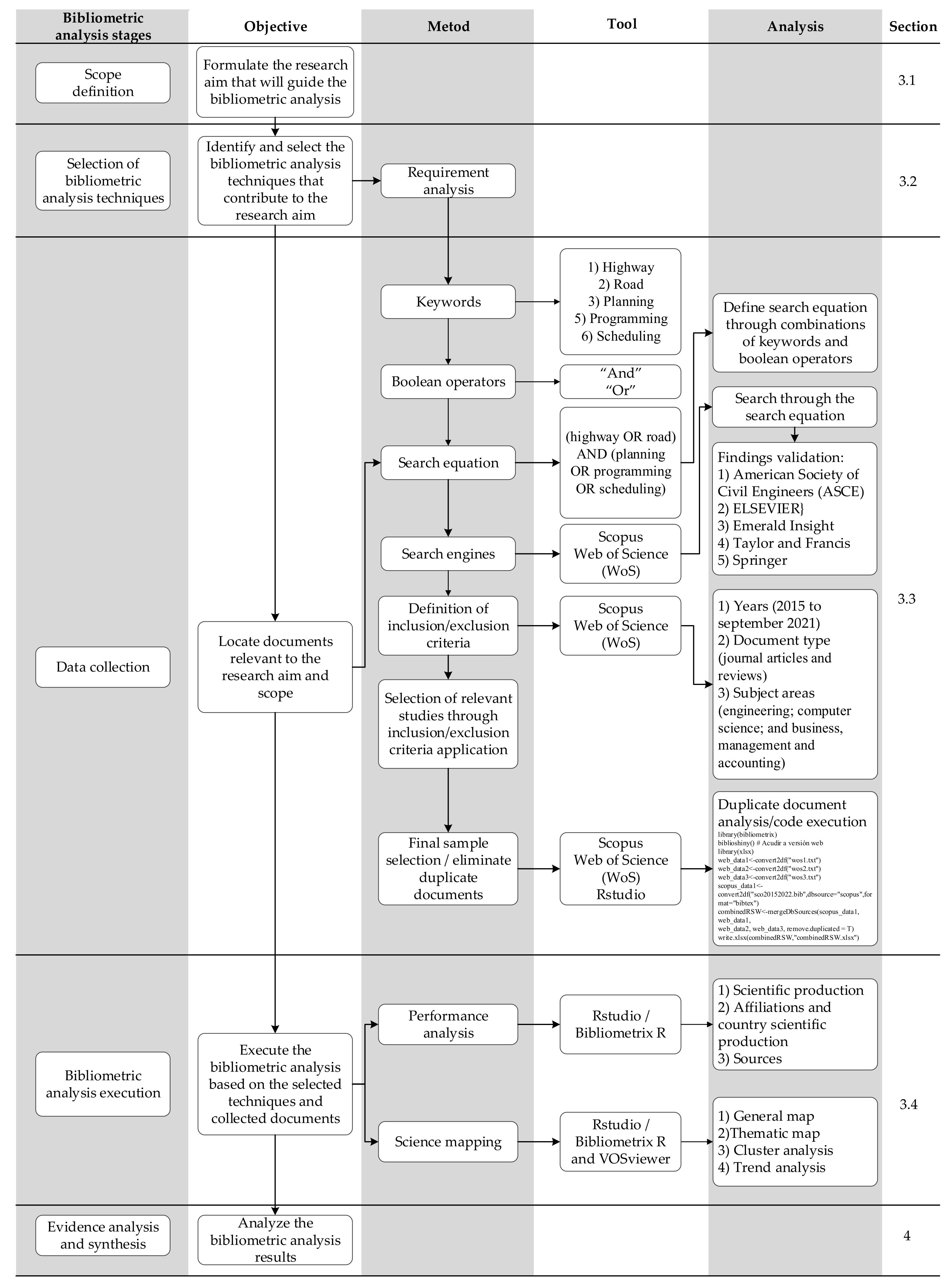
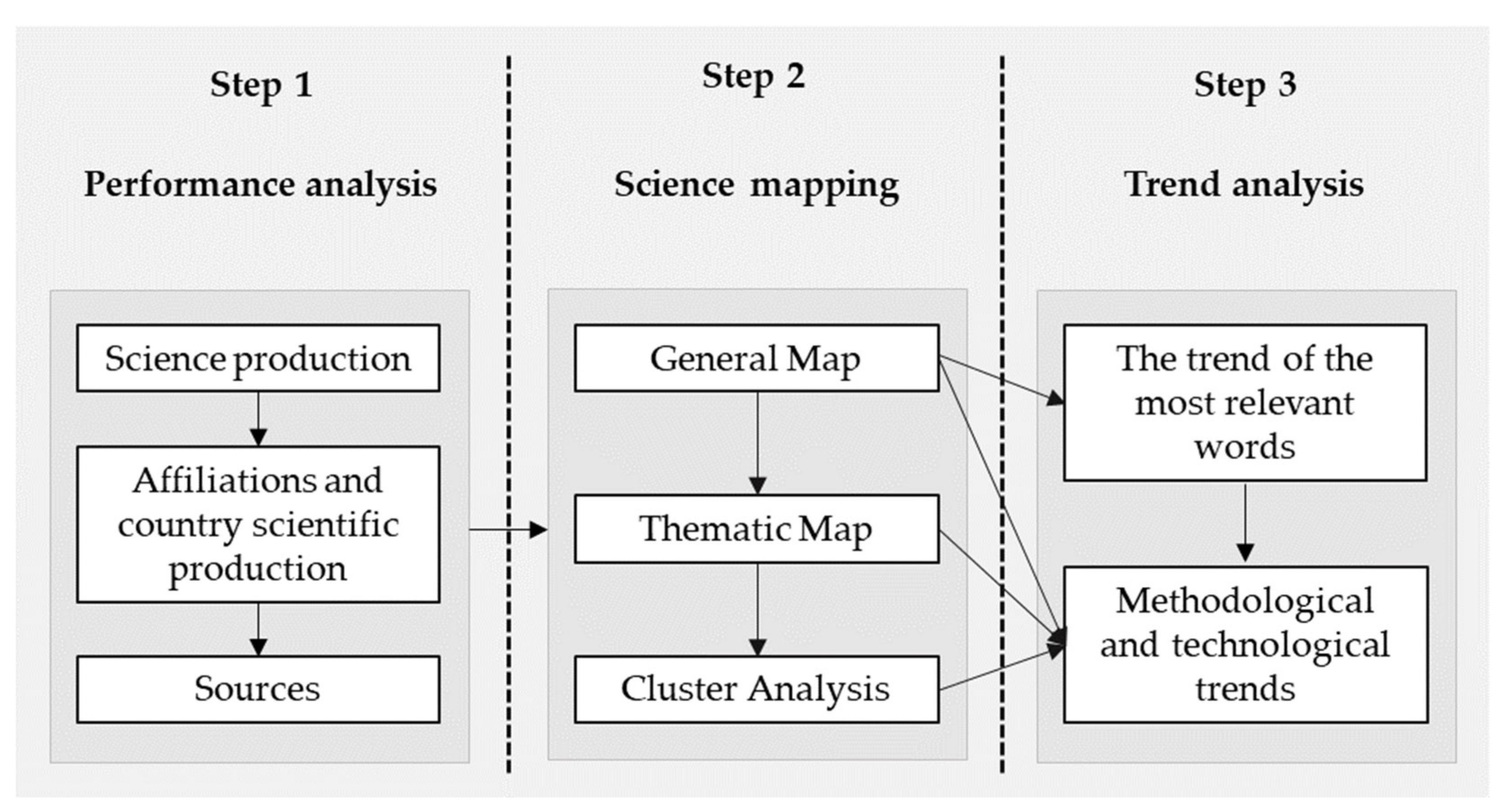

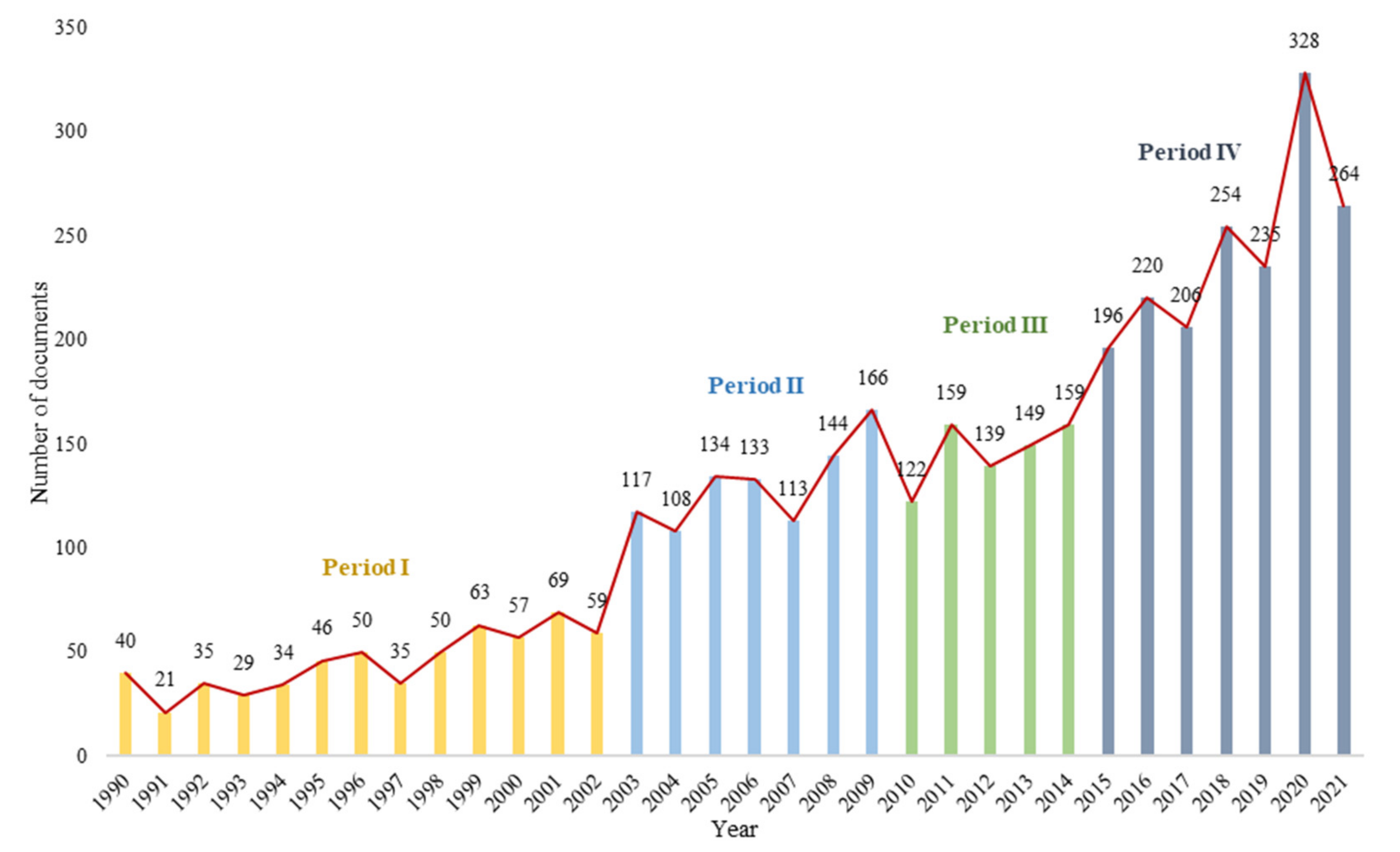


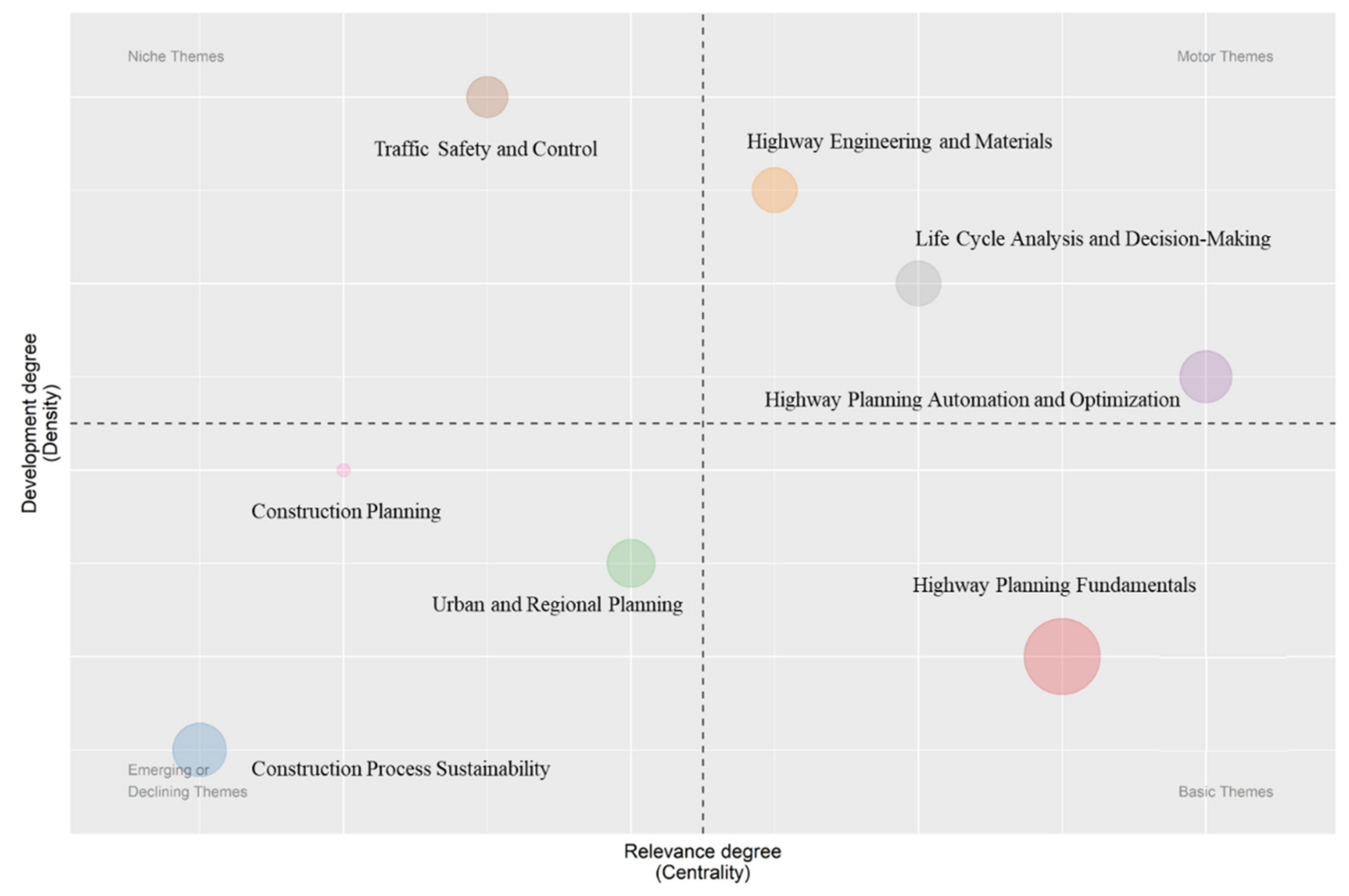
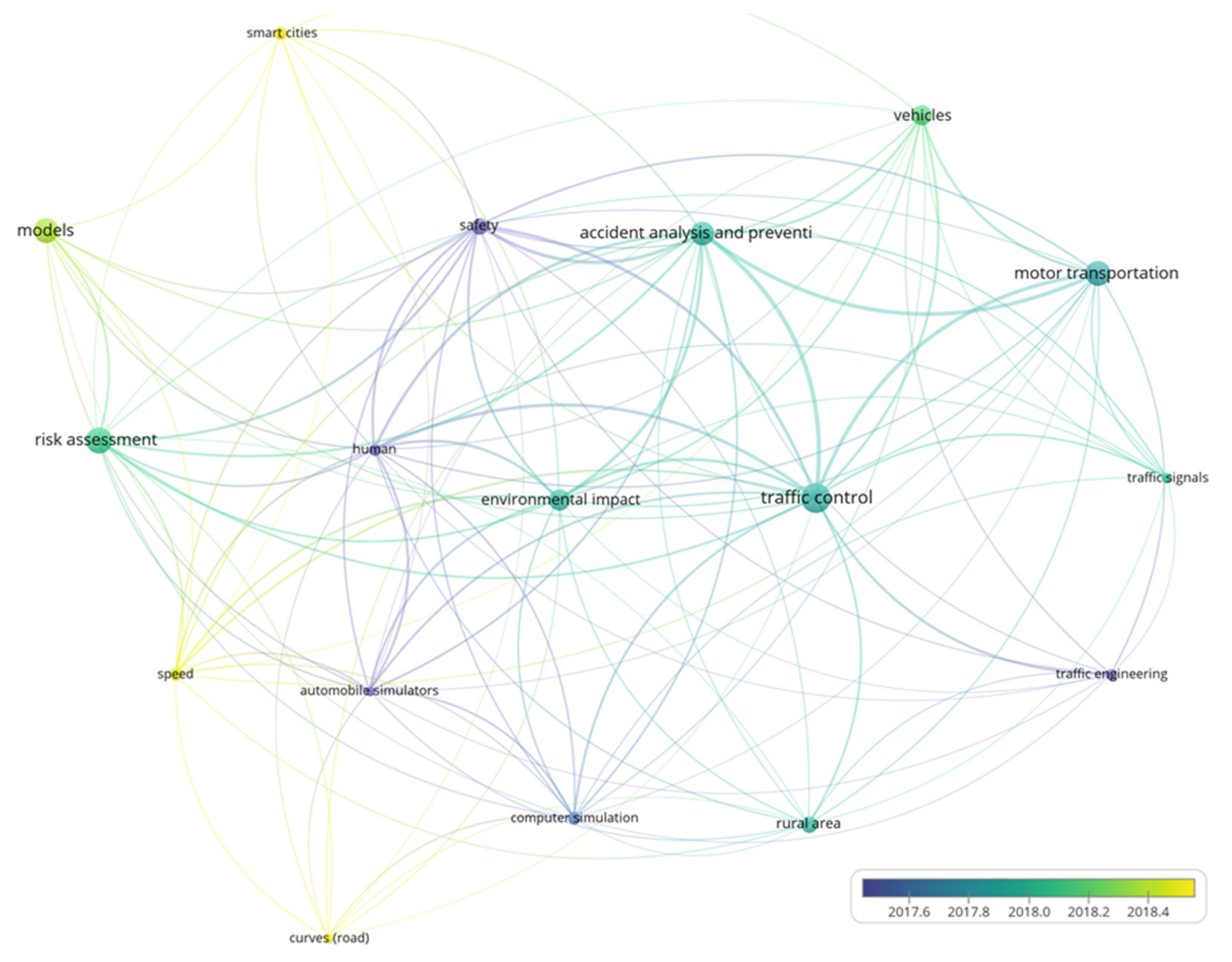
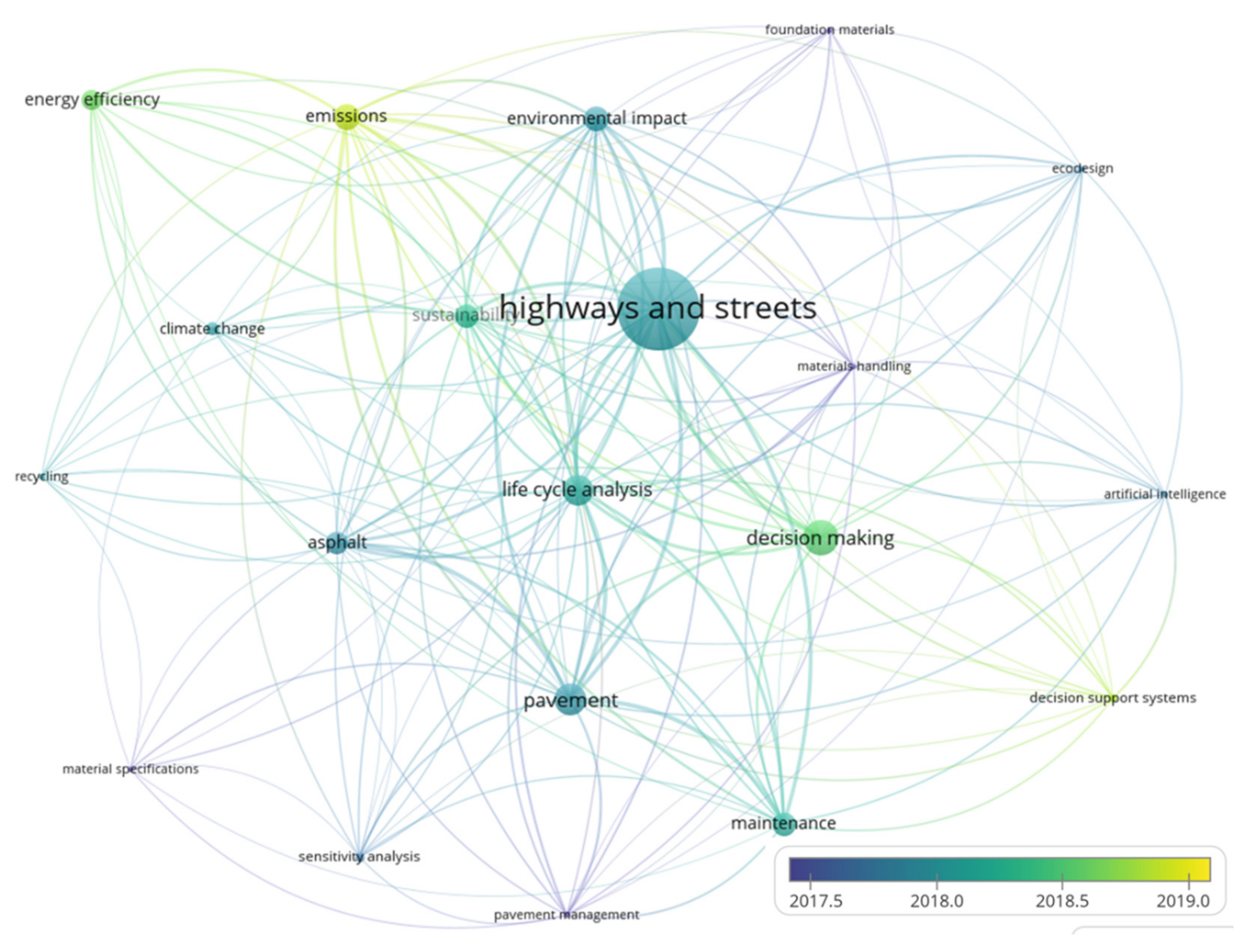
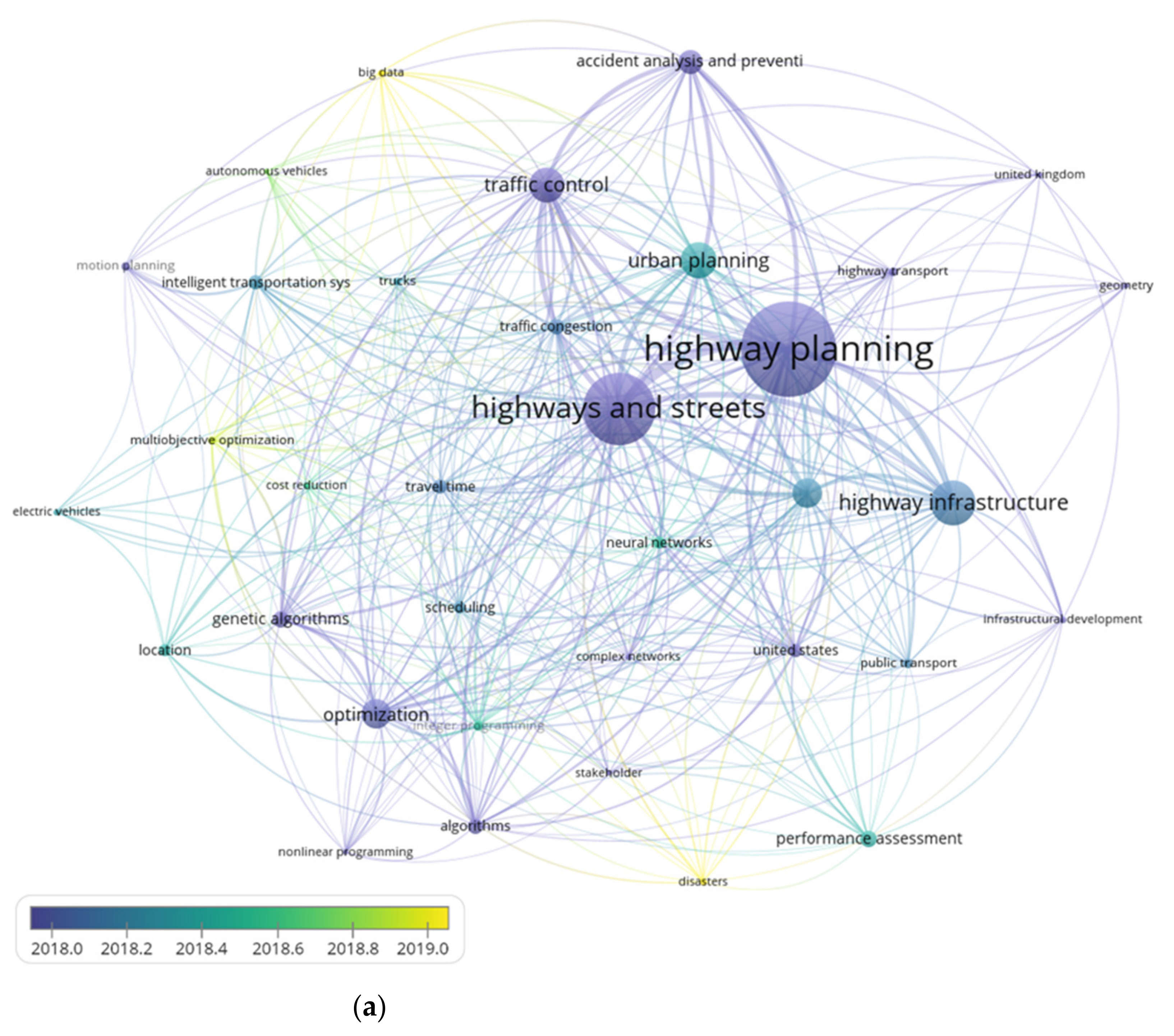
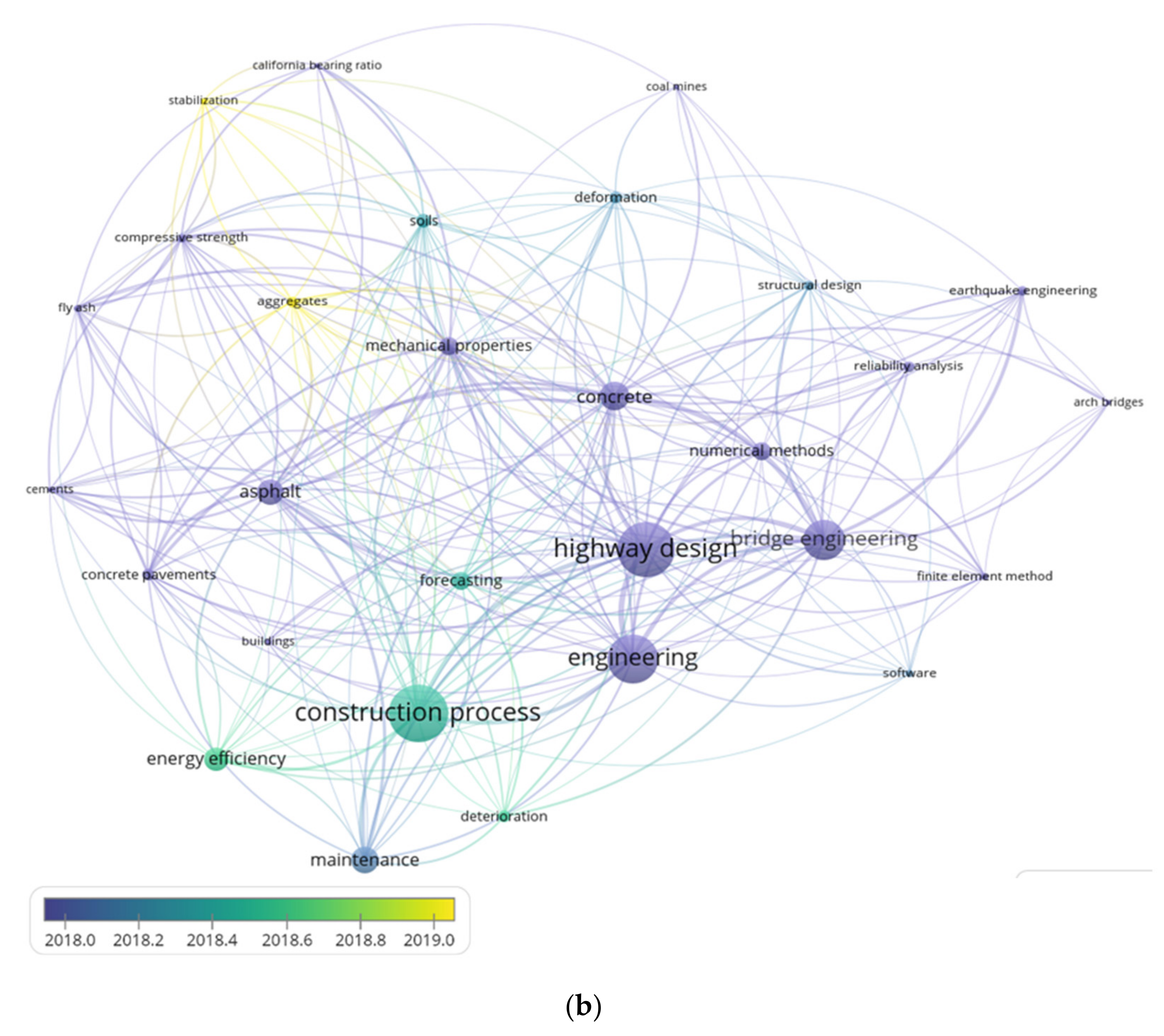
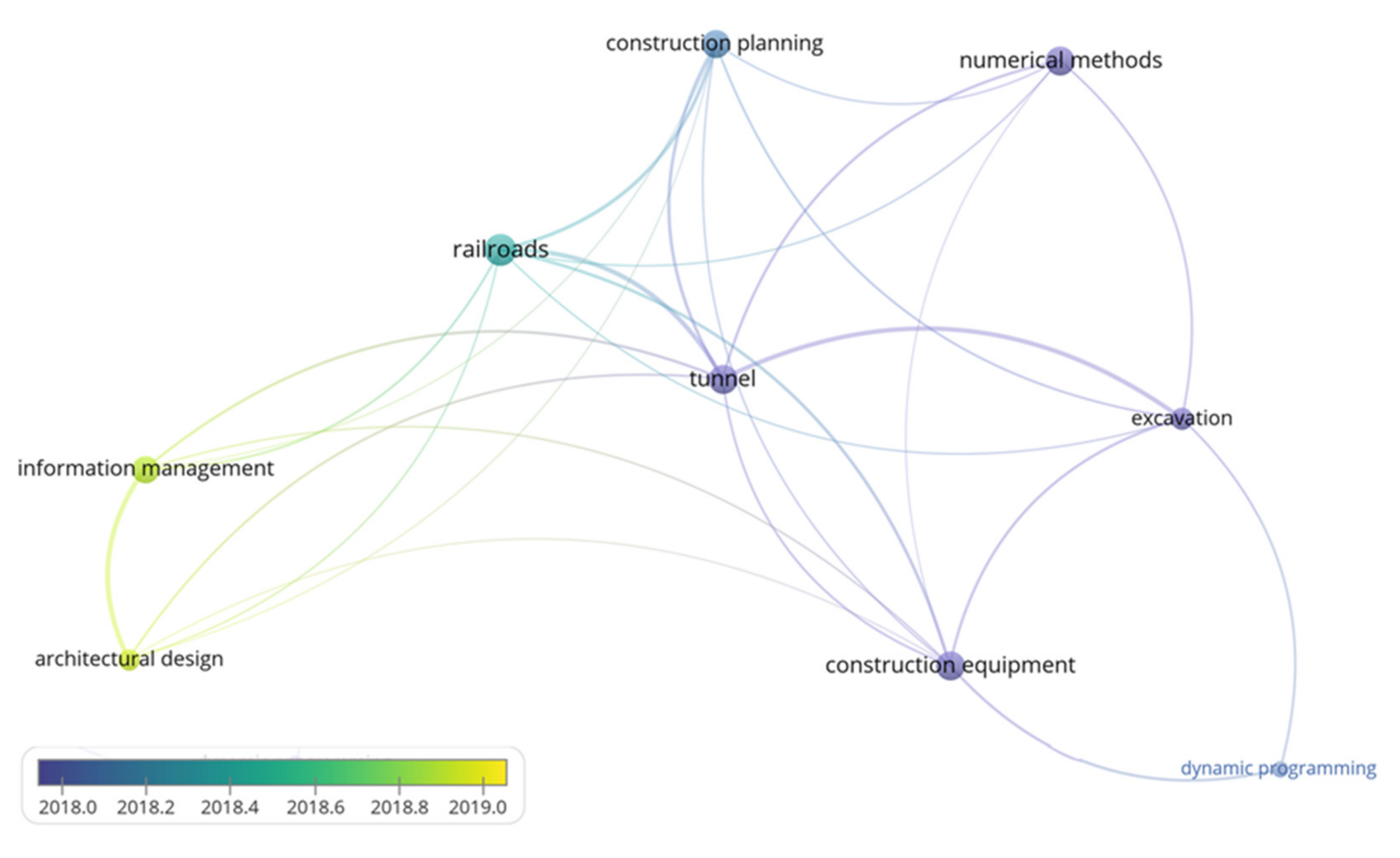
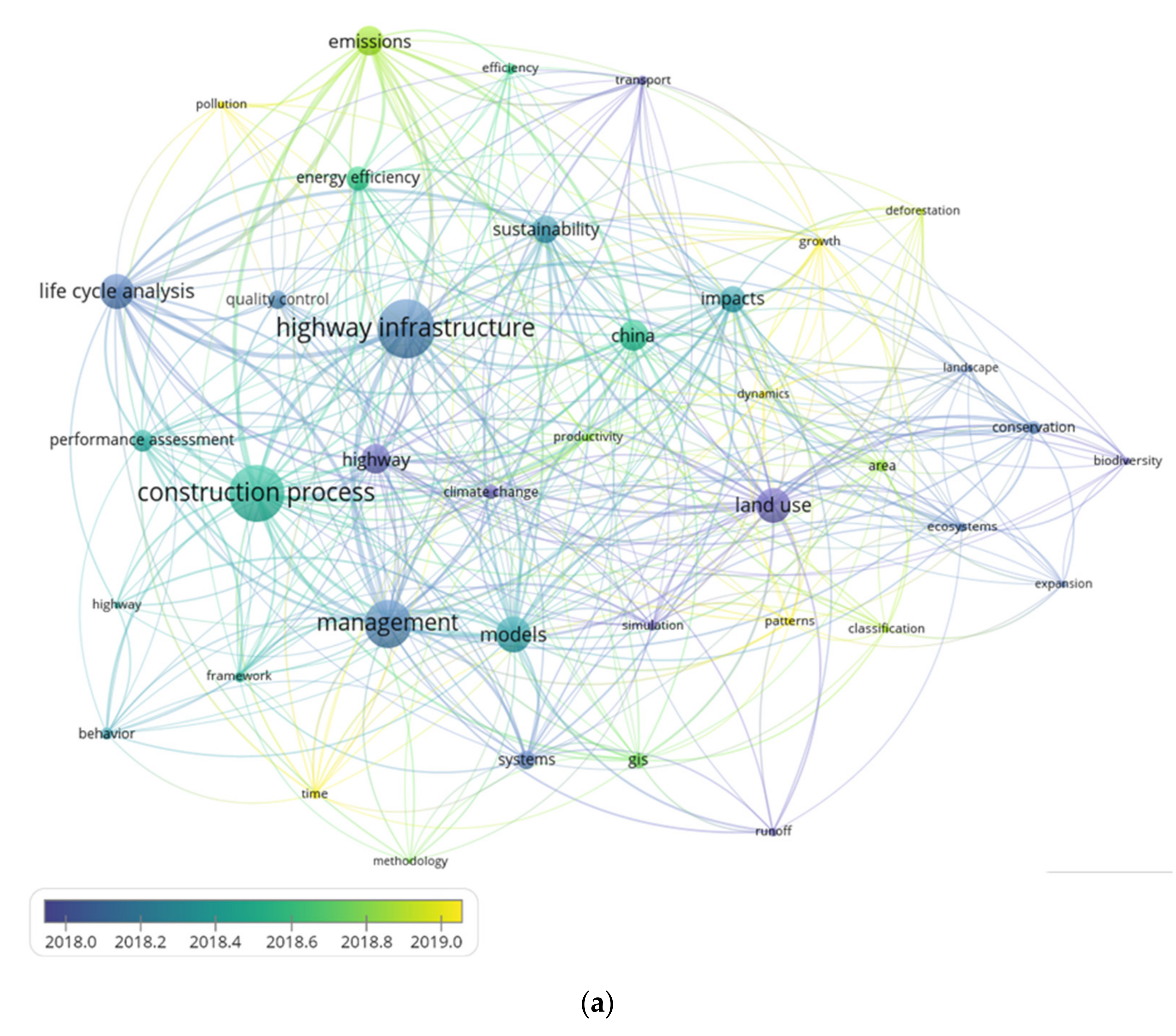
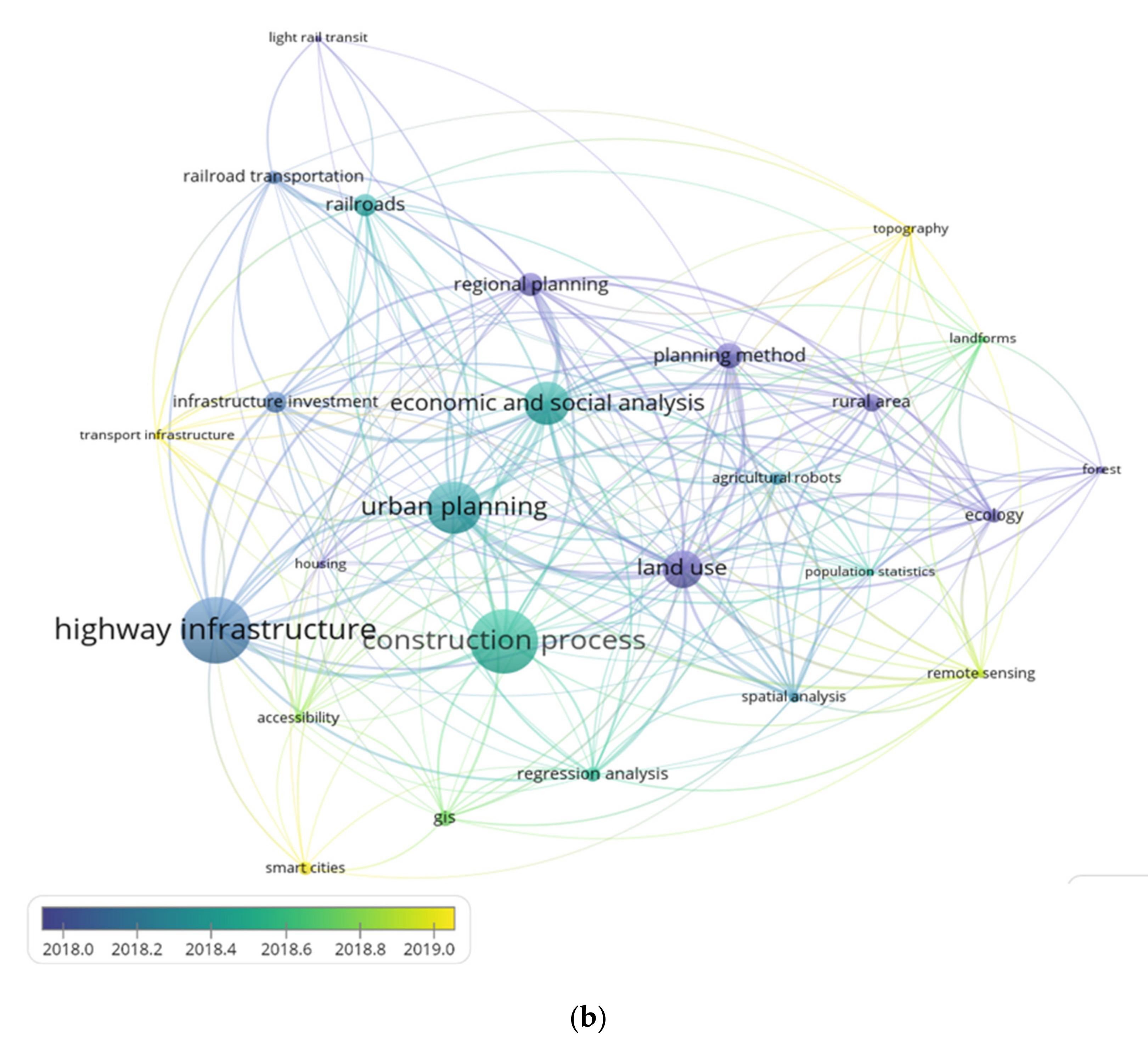
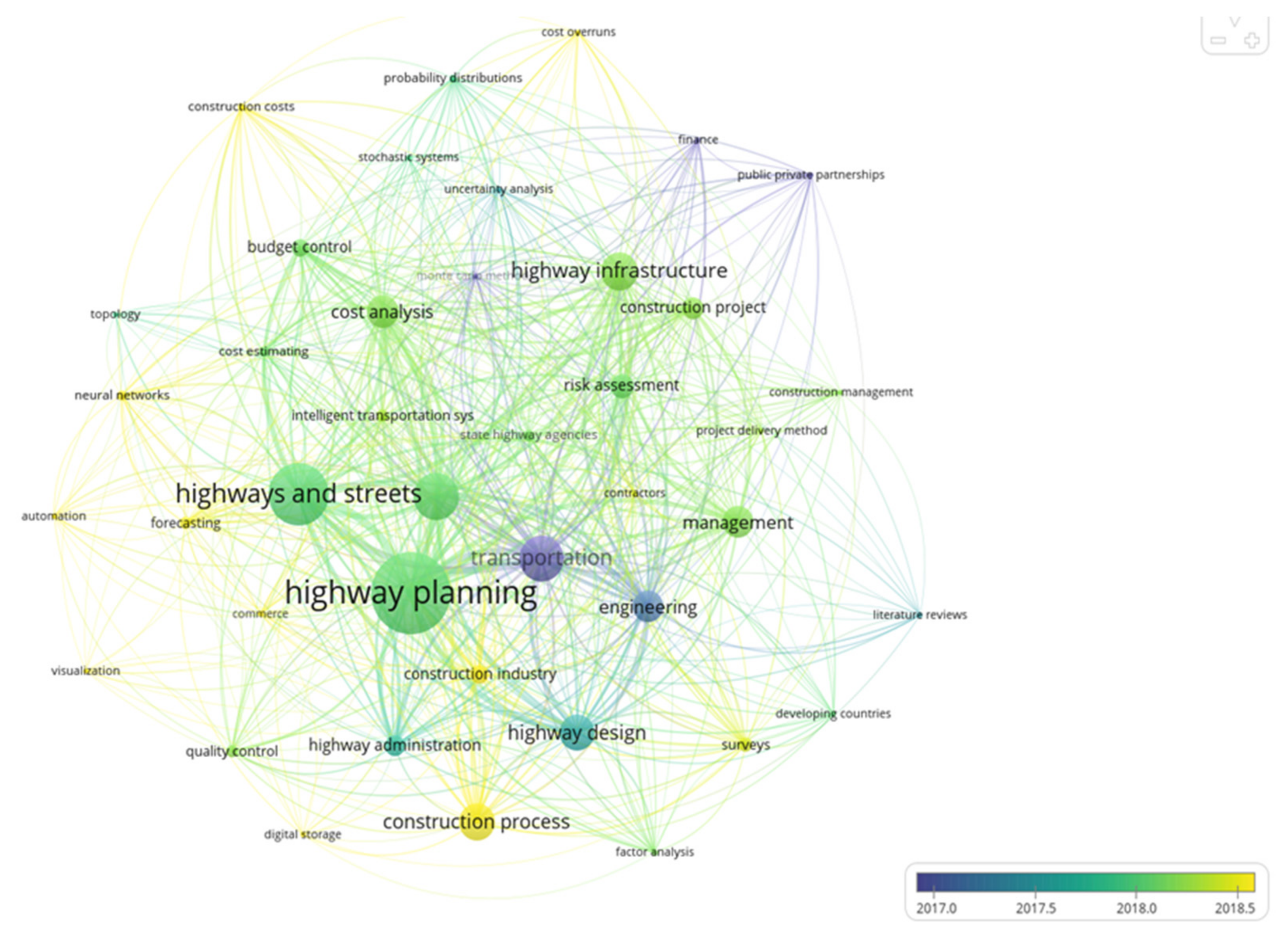

| Study | Emissions and Air Pollution | Highway Construction | Highway Planning | Highway Safety | Pavement Materials | Soils | Transport and Traffic | Intelligent Transportation Systems | Smart Cities | Unmanned Aerial vehicles (Uav) | Vehicular Issues |
|---|---|---|---|---|---|---|---|---|---|---|---|
| Zamani et al. [56] | ✅ | ||||||||||
| Wang et al. [57] | ✅ | ||||||||||
| Angarita et al. [49] | ✅ | ||||||||||
| Haghani et al. [50] | ✅ | ||||||||||
| Sood et al. [58] | ✅ | ||||||||||
| Rodríguez et al. [59] | ✅ | ||||||||||
| Siri et al. [53] | ✅ | ||||||||||
| Nalbandian et al. [60] | ✅ | ||||||||||
| Kaffas et al. [54] | ✅ | ||||||||||
| Abdelmageed and Zayed [61] | ✅ | ||||||||||
| Han et al. [62] | ✅ | ||||||||||
| Meyer [63] | ✅ | ||||||||||
| Chang et al. [64] | ✅ | ||||||||||
| Astarita et al. [55] | ✅ | ||||||||||
| Ospina et al. [51] | ✅ | ||||||||||
| Zou and Vu [52] | ✅ | ||||||||||
| Domínguez and Mateo [65] | ✅ | ✅ | |||||||||
| Wolff et al. [66] | ✅ | ||||||||||
| Moral et al. [67] | ✅ | ||||||||||
| This study | ✅ |
| Period | Year | Documents | Variation | Average | Period | Year | Documents | Variation | Average |
|---|---|---|---|---|---|---|---|---|---|
| I | 1990 | 40 | 8.3% | II | 2006 | 133 | −0.7% | ||
| 1991 | 21 | −47.5% | 2007 | 113 | −15.0% | ||||
| 1992 | 35 | 66.7% | 2008 | 144 | 27.4% | ||||
| 1993 | 29 | −17.1% | 2009 | 166 | 15.3% | ||||
| 1994 | 34 | 17.2% | III | 2010 | 122 | −26.5% | 1.0% | ||
| 1995 | 46 | 35.3% | 2011 | 159 | 30.3% | ||||
| 1996 | 50 | 8.7% | 2012 | 139 | −12.6% | ||||
| 1997 | 35 | −30.0% | 2013 | 149 | 7.2% | ||||
| 1998 | 50 | 42.9% | 2014 | 159 | 6.7% | ||||
| 1999 | 63 | 26.0% | IV | 2015 | 196 | 23.3% | 9.3% | ||
| 2000 | 57 | −9.5% | 2016 | 220 | 12.2% | ||||
| 2001 | 69 | 21.1% | 2017 | 206 | −6.4% | ||||
| 2002 | 59 | −14.5% | 2018 | 254 | 23.3% | ||||
| II | 2003 | 117 | 98.3% | 38.2% | 2019 | 235 | −7.5% | ||
| 2004 | 108 | −7.7% | 2020 | 328 | 39.6% | ||||
| 2005 | 134 | 24.1% | 2021 | 264 | −19.5% |
| Id | Affiliations | Country | Number of Documents by Year | |||||||
|---|---|---|---|---|---|---|---|---|---|---|
| 2015 | 2016 | 2017 | 2018 | 2019 | 2020 | 2021 | Total | |||
| 1 | Southwest Jiaotong University | China | 0 | 4 | 4 | 4 | 0 | 18 | 4 | 34 |
| 2 | Chang’An University | China | 5 | 3 | 4 | 8 | 3 | 2 | 8 | 33 |
| 3 | Beijing Jiaotong University | China | 6 | 2 | 9 | 5 | 2 | 4 | 4 | 32 |
| 4 | Southeast University | China | 1 | 2 | 1 | 8 | 4 | 5 | 7 | 28 |
| 5 | Purdue University | United States | 2 | 5 | 6 | 2 | 4 | 3 | 1 | 23 |
| 6 | Tongji University | China | 3 | 0 | 1 | 5 | 4 | 5 | 5 | 23 |
| 7 | The Hong Kong Polytechnic University | China | 0 | 1 | 1 | 5 | 8 | 6 | 2 | 23 |
| 8 | Texas A&M University | United States | 3 | 1 | 5 | 1 | 2 | 5 | 5 | 22 |
| 9 | Wuhan University | China | 3 | 0 | 2 | 4 | 1 | 5 | 5 | 20 |
| 10 | University of Chinese Academy of Science | China | 0 | 8 | 1 | 0 | 1 | 5 | 5 | 20 |
| 11 | Chongqing University | China | 0 | 1 | 1 | 4 | 6 | 4 | 1 | 17 |
| 12 | Iowa State University | United States | 2 | 4 | 4 | 3 | 1 | 1 | 1 | 16 |
| 13 | University of Kansas | United States | 1 | 3 | 2 | 2 | 0 | 5 | 1 | 14 |
| 14 | Tsinghua University | China | 2 | 4 | 2 | 2 | 1 | 2 | 0 | 13 |
| 15 | Arizona State University | United States | 2 | 2 | 1 | 1 | 2 | 2 | 2 | 12 |
| 16 | Shenzhen University | China | 0 | 0 | 2 | 2 | 4 | 2 | 2 | 12 |
| 17 | Beijing Normal University | China | 0 | 2 | 2 | 0 | 3 | 3 | 0 | 10 |
| 18 | Curtin University | Australia | 2 | 3 | 1 | 0 | 3 | 1 | 0 | 10 |
| 19 | Zhejiang University | China | 0 | 1 | 0 | 1 | 2 | 3 | 3 | 10 |
| 20 | Tianjin University | China | 0 | 0 | 1 | 3 | 0 | 2 | 3 | 9 |
| Id | Sources | Number of Documents | Total Cites | C. per Document | |||||||
|---|---|---|---|---|---|---|---|---|---|---|---|
| 2015 | 2016 | 2017 | 2018 | 2019 | 2020 | 2021 | Total | ||||
| 1 | Transportation Research Record | 11 | 13 | 8 | 13 | 7 | 8 | 0 | 60 | 223 | 3.72 |
| 2 | Sustainability | 3 | 3 | 2 | 10 | 8 | 16 | 12 | 54 | 73 | 1.35 |
| 3 | Journal of Construction Engineering and Management | 4 | 4 | 6 | 4 | 6 | 5 | 9 | 38 | 358 | 9.42 |
| 4 | Journal of Cleaner Production | 1 | 1 | 7 | 3 | 5 | 9 | 11 | 37 | 72 | 1.95 |
| 5 | Bautechnik | 0 | 3 | 9 | 4 | 2 | 6 | 5 | 29 | 13 | 0.45 |
| 6 | Journal of Management in Engineering | 3 | 1 | 0 | 6 | 3 | 7 | 5 | 25 | 53 | 2.12 |
| 7 | Nongye Gongcheng Xuebao/Transactions of the Chinese Society of Agricultural Engineering | 2 | 3 | 3 | 6 | 3 | 3 | 2 | 22 | 101 | 4.59 |
| 8 | Accident Analysis and Prevention | 2 | 4 | 0 | 7 | 2 | 1 | 2 | 18 | 15 | 0.83 |
| 9 | Automation in Construction | 1 | 3 | 2 | 4 | 1 | 3 | 4 | 18 | 138 | 7.67 |
| 10 | Construction and Building Materials | 0 | 1 | 2 | 4 | 1 | 5 | 5 | 18 | 57 | 3.17 |
| 11 | Engineering Construction and Architectural Management | 0 | 1 | 5 | 0 | 2 | 5 | 4 | 17 | 19 | 1.12 |
| 12 | International Journal of Construction Management | 0 | 2 | 0 | 2 | 4 | 2 | 5 | 15 | 14 | 0.93 |
| 13 | Journal of Advanced Transportation | 1 | 0 | 1 | 5 | 1 | 5 | 1 | 14 | 32 | 2.29 |
| 14 | Journal of Railway Engineering Society | 1 | 3 | 3 | 1 | 3 | 1 | 2 | 14 | 16 | 1.14 |
| 15 | Tunnelling and Underground Space Technology | 1 | 2 | 2 | 3 | 2 | 3 | 1 | 14 | 22 | 1.57 |
| 16 | Zhongguo Gonglu Xuebao/China Journal of Highway and Transport | 3 | 3 | 1 | 2 | 2 | 1 | 2 | 14 | 61 | 4.36 |
| 17 | International Journal of Pavement Engineering | 4 | 0 | 2 | 2 | 3 | 2 | 0 | 13 | 47 | 3.62 |
| 18 | Remote Sensing | 0 | 0 | 0 | 0 | 2 | 8 | 3 | 13 | 13 | 1.00 |
| 19 | Journal of Infrastructure Systems | 2 | 4 | 0 | 0 | 0 | 3 | 3 | 12 | 51 | 4.25 |
| 20 | IEEE Access | 0 | 0 | 0 | 1 | 2 | 7 | 1 | 11 | 49 | 4.45 |
| Methodological and Technological Trends in Highway Planning | Highway Planning Trend Fields | ||||||||||||||||||
|---|---|---|---|---|---|---|---|---|---|---|---|---|---|---|---|---|---|---|---|
| Sustainability | Project Management | Accident Prevention and Analysis | Urban Planning | Highway Engineering | |||||||||||||||
| Energy Efficiency | Emission Reduction | Sustainable Development | Environmental Impact | Cost Analysis | Risk Management | Decision-Making Process | Schedule Management | Project Management | Highway Safety Management | Quality Control | Reliability Analysis | Economic and Social analysis | Urban and Regional Planning | New Materials | Traffic analysis and Management | Route Planning | Highway Construction | Highway Design | |
| Accuracy assessment | 1 | 0 | 0 | 0 | 8 | 0 | 1 | 0 | 1 | 0 | 0 | 0 | 0 | 1 | 0 | 3 | 0 | 6 | 0 |
| Artificial intelligence | 0 | 0 | 1 | 3 | 4 | 1 | 11 | 0 | 5 | 1 | 0 | 0 | 3 | 4 | 4 | 3 | 1 | 8 | 4 |
| Autonomous and electric vehicles | 17 | 2 | 4 | 6 | 21 | 3 | 5 | 0 | 6 | 18 | 0 | 1 | 6 | 8 | 4 | 31 | 15 | 18 | 8 |
| Bayesian networks | 0 | 2 | 2 | 3 | 10 | 1 | 5 | 1 | 3 | 5 | 0 | 0 | 3 | 9 | 0 | 7 | 1 | 8 | 2 |
| Big data | 2 | 0 | 1 | 1 | 7 | 1 | 5 | 3 | 6 | 7 | 0 | 0 | 3 | 10 | 0 | 19 | 3 | 17 | 5 |
| BIM | 0 | 1 | 0 | 2 | 3 | 3 | 1 | 1 | 13 | 3 | 0 | 0 | 0 | 7 | 0 | 1 | 0 | 13 | 4 |
| Clustering algorithms | 1 | 0 | 0 | 0 | 0 | 0 | 0 | 0 | 0 | 0 | 0 | 0 | 0 | 1 | 0 | 5 | 0 | 0 | 0 |
| Computer programming | 11 | 14 | 1 | 6 | 31 | 3 | 12 | 10 | 4 | 7 | 3 | 2 | 8 | 23 | 14 | 20 | 7 | 51 | 8 |
| Computer simulation | 2 | 1 | 2 | 16 | 13 | 10 | 9 | 2 | 2 | 30 | 1 | 2 | 1 | 13 | 6 | 27 | 2 | 26 | 19 |
| Factor analysis | 0 | 2 | 1 | 3 | 6 | 5 | 3 | 0 | 1 | 2 | 1 | 2 | 4 | 14 | 0 | 4 | 1 | 13 | 9 |
| Finite element method | 0 | 0 | 0 | 0 | 0 | 0 | 0 | 0 | 1 | 0 | 0 | 0 | 1 | 0 | 9 | 0 | 0 | 2 | 4 |
| Fuzzy logic | 0 | 0 | 0 | 1 | 0 | 2 | 3 | 0 | 0 | 0 | 1 | 0 | 0 | 2 | 0 | 2 | 0 | 5 | 1 |
| Genetic algorithms | 3 | 3 | 1 | 4 | 11 | 2 | 10 | 6 | 1 | 5 | 1 | 0 | 7 | 4 | 3 | 12 | 4 | 32 | 4 |
| GIS | 2 | 0 | 1 | 1 | 4 | 1 | 4 | 0 | 2 | 0 | 1 | 0 | 1 | 13 | 0 | 2 | 1 | 10 | 1 |
| Heuristic algorithms | 0 | 0 | 0 | 1 | 4 | 0 | 1 | 1 | 0 | 0 | 0 | 0 | 0 | 1 | 0 | 6 | 2 | 1 | 1 |
| Intelligent systems | 9 | 1 | 3 | 6 | 11 | 7 | 5 | 1 | 7 | 7 | 4 | 4 | 1 | 7 | 1 | 15 | 12 | 17 | 7 |
| Life cycle assessment | 7 | 28 | 10 | 18 | 49 | 9 | 20 | 1 | 14 | 8 | 4 | 1 | 8 | 11 | 22 | 5 | 3 | 56 | 17 |
| Monte Carlo methods | 2 | 1 | 0 | 1 | 7 | 4 | 3 | 0 | 1 | 1 | 1 | 2 | 0 | 0 | 1 | 2 | 0 | 14 | 4 |
| Multi-objective optimization | 7 | 15 | 9 | 15 | 53 | 12 | 26 | 15 | 8 | 10 | 7 | 2 | 25 | 18 | 11 | 47 | 13 | 86 | 28 |
| Neural networks | 1 | 0 | 2 | 2 | 15 | 1 | 2 | 2 | 1 | 0 | 2 | 0 | 4 | 8 | 0 | 3 | 3 | 12 | 4 |
| Numerical models | 1 | 4 | 2 | 2 | 21 | 3 | 4 | 3 | 0 | 0 | 0 | 1 | 3 | 6 | 10 | 12 | 3 | 23 | 7 |
| Performance assessment | 3 | 5 | 4 | 7 | 22 | 10 | 5 | 3 | 2 | 3 | 3 | 1 | 2 | 10 | 10 | 8 | 1 | 40 | 11 |
| Principal component analysis | 0 | 0 | 0 | 0 | 0 | 1 | 0 | 0 | 0 | 1 | 0 | 0 | 2 | 7 | 0 | 0 | 0 | 4 | 2 |
| Regression analysis | 1 | 2 | 1 | 8 | 17 | 2 | 3 | 0 | 1 | 8 | 2 | 0 | 6 | 16 | 2 | 9 | 0 | 19 | 6 |
| Remote sensing | 1 | 0 | 2 | 13 | 0 | 1 | 0 | 0 | 0 | 0 | 4 | 0 | 4 | 28 | 0 | 0 | 2 | 4 | 1 |
| Robots | 2 | 0 | 0 | 1 | 2 | 0 | 1 | 0 | 0 | 0 | 0 | 0 | 1 | 1 | 1 | 1 | 8 | 2 | 2 |
| Sensitive analysis | 0 | 4 | 3 | 3 | 14 | 2 | 6 | 1 | 4 | 3 | 1 | 0 | 3 | 6 | 7 | 4 | 2 | 7 | 4 |
| Smart cities | 4 | 4 | 3 | 5 | 4 | 1 | 2 | 1 | 1 | 8 | 1 | 1 | 1 | 12 | 0 | 7 | 0 | 2 | 3 |
| Spatial analysis | 0 | 0 | 3 | 12 | 2 | 2 | 2 | 0 | 1 | 4 | 0 | 0 | 7 | 32 | 0 | 2 | 1 | 5 | 1 |
| Uncertainty analysis | 1 | 3 | 1 | 2 | 10 | 7 | 6 | 1 | 1 | 1 | 0 | 1 | 2 | 1 | 5 | 0 | 0 | 13 | 3 |
| Unmanned aerial vehicles (uav) | 2 | 0 | 0 | 0 | 0 | 0 | 2 | 0 | 0 | 0 | 0 | 0 | 0 | 1 | 0 | 1 | 2 | 0 | 0 |
Publisher’s Note: MDPI stays neutral with regard to jurisdictional claims in published maps and institutional affiliations. |
© 2022 by the authors. Licensee MDPI, Basel, Switzerland. This article is an open access article distributed under the terms and conditions of the Creative Commons Attribution (CC BY) license (https://creativecommons.org/licenses/by/4.0/).
Share and Cite
Castañeda, K.; Sánchez, O.; Herrera, R.F.; Mejía, G. Highway Planning Trends: A Bibliometric Analysis. Sustainability 2022, 14, 5544. https://doi.org/10.3390/su14095544
Castañeda K, Sánchez O, Herrera RF, Mejía G. Highway Planning Trends: A Bibliometric Analysis. Sustainability. 2022; 14(9):5544. https://doi.org/10.3390/su14095544
Chicago/Turabian StyleCastañeda, Karen, Omar Sánchez, Rodrigo F. Herrera, and Guillermo Mejía. 2022. "Highway Planning Trends: A Bibliometric Analysis" Sustainability 14, no. 9: 5544. https://doi.org/10.3390/su14095544
APA StyleCastañeda, K., Sánchez, O., Herrera, R. F., & Mejía, G. (2022). Highway Planning Trends: A Bibliometric Analysis. Sustainability, 14(9), 5544. https://doi.org/10.3390/su14095544








